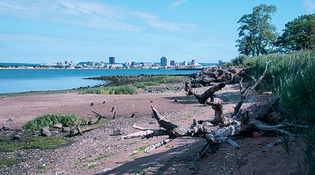 loading
loading
New HavenClose to the edgeA coastal city prepares for rising seas.  Mark Zurolo ’01MFANew Haven’s East Shore Park, which faces the city’s harbor, will see its natural shoreline restored to absorb more water from storms and rising oceans. View full imageWhen Hurricane Sandy lashed the southern New England coast in 2012, New Haven County was among the hardest-hit places in Connecticut. The damage cost tens of millions. And that was just one of the major storms to hit the area in recent years. For cities like New Haven, planning for coastal hazards like flooding, storm surges, and rising sea levels is not optional. Much of New Haven is vulnerable, including Union Station, Long Wharf, Tweed–New Haven Airport, and areas near the Quinnipiac, Mill, and West Rivers. On top of that, Connecticut as a whole has some special challenges. Sixty percent of the state’s inhabitants live in coastal communities, with many structures perched just inches above an ocean that is expected to rise four feet in the coming century. The state ranks behind only Florida on the list of eastern states with vulnerable coastal assets. Then there is Connecticut’s home-rule law—which can make it behave less like a state and more like a group of fiercely independent cities. Regional planning is tough when municipalities have their own priorities. And Connecticut’s geology can also work against unity, because its many north-south ridges make coastal hazards patchy: some homeowners are threatened by wave erosion, others by winter storms. People facing different risks can find it hard to agree on how to spend taxpayer dollars. Fortunately, we know much more about dealing with coastal dangers than we used to. It has become clear that the standard bulwarks—berms, seawalls, and similar constructions—don’t work as well as living shorelines and natural defenses like barrier islands, sand dunes, reefs, and coastal wetlands. But humans have learned how to build these defenses. Connecticut is considering several now. One Yale faculty member deeply involved in these efforts is Alexander Felson, a landscape architect and urban ecologist. Among other projects, he helped develop a coastal resilience plan for Guilford that is now a model for other Connecticut towns. He spearheaded what he says is the state’s first coastal green infrastructure: bio-retention gardens in a flood-prone part of Bridgeport. “Our niche is integrating ecological experiments with urban design,” Felson explains. His Urban Ecology and Design Laboratory helps cities take living systems into account. An associate professor in the School of Architecture, Felson is working with state, regional, and nonprofit organizations focused on the coast. In his class Ecological Urban Design, students of architecture, management, and forestry analyze coastal cities’ hazards, creating proposals that will inform the work of Connecticut coastal resilience planners. Felson teaches his students to pursue innovative projects, and—because nothing will get built unless designers and builders can cut through red tape—he also teaches them how to navigate political, ecological, and infrastructural constraints. Felson and his students also study the Bridgeport gardens, exploring links between habitat function and storm water management. Historically, “engineers avoided designing green infrastructure in coastal areas because the water table is high,” he says. “We’re defining how coastal-area green infrastructure works, which is a whole new area.” Other projects are moving forward. In January 2016, $8 million of a $54 million federal grant went to the University of Connecticut and Felson’s lab to fund coastal resilience planning for two counties. New Haven and the Connecticut Fund for the Environment are working to restore a marsh in East Shore Park. And the city is building 200 “bioswales” around town: gardens that soak up precipitation so that storms don’t overwhelm the sewer system and flood the train station. For coastal cities, there are storm clouds ahead. It’s good to know that New Haven is getting ready.
The comment period has expired.
|
|